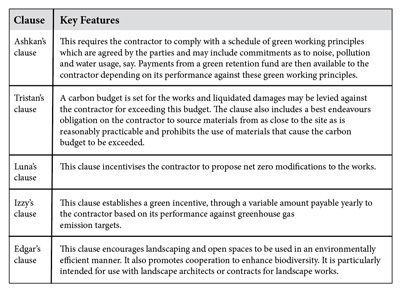Going Green – Is it time to consider the use of climate clauses in construction contracts?
Ireland has committed to halving its greenhouse gas emissions by 2030 (as compared to 2018 figures) and reaching net zero by 2050. This is an ambitious target and those working in the construction sector have a significant role in achieving it.
It is estimated that approximately 37% of carbon emissions in Ireland come from the construction and built environment: 23% from operational emissions to heat, light and cool buildings and 14% from the production and transport of construction materials, as well as the maintenance, repair and disposal of buildings and infrastructure1. The Irish construction industry can (and should) play a pivotal role in realising Ireland’s climate ambitions and may also gain commercial advantages by acting on climate change.
This article considers a key and evolving way for the sector to potentially make a difference, namely including “climate clauses” when negotiating contracts.
Why should the construction sector act on climate change?
A project’s sustainability credentials are increasingly seen as key considerations for developers, contractors, investors and funders. These considerations are driven, in part, by EU and domestic regulation aimed at speeding up decarbonisation.
There are now requirements for the financial sector and large corporates to report on the sustainability of their activities. As was covered in our article in Issue 2 last year, the EU Taxonomy Regulation provides a classification system for determining whether an economic activity is environmentally sustainable, to help underpin these requirements, and there is real value for entities of all sizes in considering how they measure up.
There are now also a number of online databases and tools that benchmark the sustainability of entities, assets, products and materials. A new Corporate Sustainability Due Diligence Directive is also being negotiated which is likely to have a significant impact.
Other drivers include reputational risk, potential insurance risk of failing to factor in climate change and appropriate mitigation and, finally, the desire to “do the right thing” – the latter, from what we are seeing, should not be underestimated.
All in all, there is an increased appetite among investors for sustainable projects, which has resulted in new tools to promote sustainability, such as funders offering preferential interest rates to developers of ‘green’ projects. There is also data to suggest that ‘green’ properties can achieve higher rents or premiums on sale.
The push for sustainability is also leading to increased scrutiny and requirement for reporting on a project’s carbon footprint, particularly with respect to the construction supply-chain and use of materials. There is now a real demand for reliable data on emissions reduction, and an entity at any level of the supply chain that captures this data for use upstream will be a more attractive partner.
Increasingly, those companies which embrace and implement green approaches to business are likely to enjoy commercial advantages over competitors.
Climate clauses in construction contracts
Thinking about possible climate clauses to be included in your construction contracts is a good starting point to improve sustainability.
Traditionally, requirements regarding the methods of construction, procurement of materials and performance of the completed works (all of which are likely to have climate impacts) have largely been housed in the works requirements and technical schedules to a contract.
Over recent years, this has begun to change, with LEED, BREEAM and BER requirements finding their way into the conditions of contract. However, including more structured ‘climate clauses’ in the front-end conditions of contract will bring sustainability up the agenda. It will allow a better alignment of ‘green’ objectives during negotiation, and create incentives for the supply chain to be more innovative in their processes.
Climate change clauses can also be tailored to the particular transaction and can be a more agile way to pursue change, as compared with regulation.

Examples of climate clauses
The main areas of potential reform in the construction sector with respect to emissions are the sourcing and use of materials and the energy use of completed projects. There is an abundance of resources available to assist stakeholders to craft climate clauses in these key areas. Clauses that have been developed to date are ambitious and, at this stage, may be better used as a starting point for parties to negotiate something which is both achievable and commercially acceptable.
In the UK, standard form contracts such as JCT or NEC have already developed clauses for use. For example, the supplemental provisions applicable to the JCT Design and Build Contract and the JCT Standard Building Contract (2016 Editions) allow parties to include clauses to encourage the contractor to suggest amendments to the works which, if instructed, will result in an improvement in environmental performance in the carrying out of the works or of the completed works.
Similarly, NEC has developed clause X29 for use with the NEC4 suite of main and sub-contract forms. Clause X29 is aimed at reducing the impact of the execution, operation, maintenance and demolition of works on climate change by incorporating “climate change requirements” into the contract scope. These requirements relate to matters such as levels of recycling, use of renewable power on-site or electric vehicles, reducing waste generation, designing out waste and design that reduces carbon emission. The clause also provides for a performance table to benchmark the contractor’s performance against specific targets. The parties can also provide for financial incentives.
Chancery Lane Project
In addition to climate clauses that are emerging via industry standard forms, the Chancery Lane Project (“TCLP”) is creating an ambitious suite of construction specific climate clauses 2. TCLP supports collaboration between lawyers to consider how to help clients address climate change through their contracts. These clauses (each named after a child of the author!) each touch on different aspects of the construction process and set out different mechanisms to help bring about and accelerate emissions reduction in the construction industry. A flavour of these clauses is summarised in the above table.
Climate clauses are becoming a more common feature in construction contracts. Uptake and development will likely foster further innovation to reduce emissions and this may ultimately result in cost-savings for construction parties. As the use and demand of climate clauses increases, key issues are likely to emerge in negotiations – we would expect construction parties to be particularly engaged on how the cost of climate related risks are funded, especially in the current volatile market conditions. Parties will also be interested in ensuring contractors are appropriately incentivised to comply with these expanded obligations. In addition, the availability of reliable data on carbon and emissions will be critical to assess performance under certain of these climate clauses.
These are relatively early days for the adoption by the Irish construction sector of the new mechanisms but the expectation is that we will see a steady increase in their prevalence in the market, as they become embedded as a part of a larger conversation happening in the sector. Timely for Spring, but construction is certainly getting greener!

